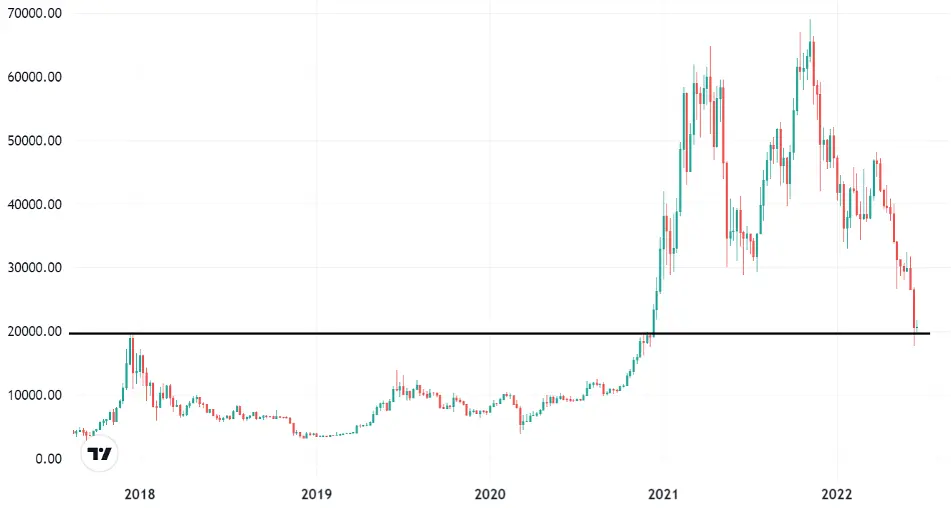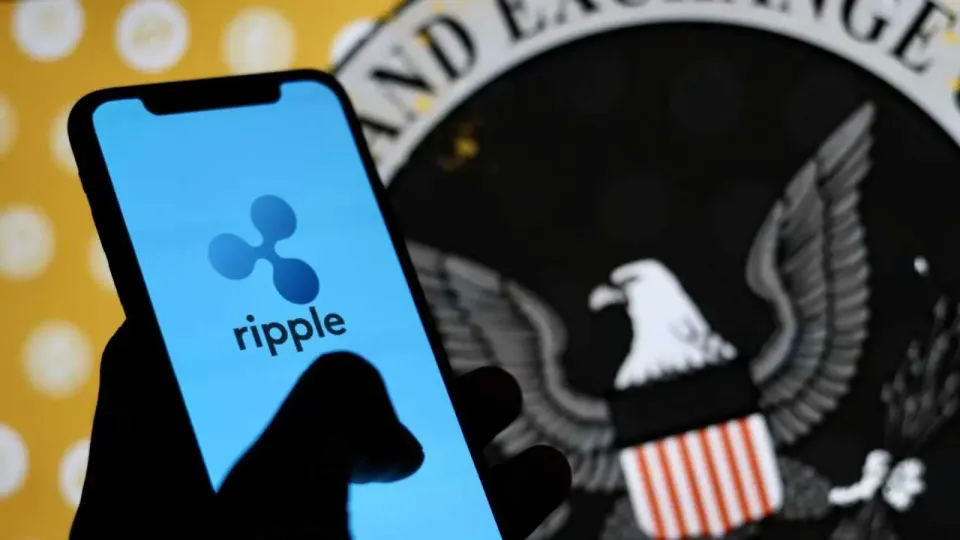Colombia to Follow El Salvador?
Crypto Market Week in Review (24 June 2022)
Markets
This week crypto assets stabilized after the previous week’s drop. Traditional financial assets recovered, with both stocks and bonds supported by lower commodity prices.
On Saturday Bitcoin decreased below the psychologically and technically important level of $20000 (see the chart below), but swiftly recovered back above it. That leg down was probably explained by forced selling. BlockFi said that it had liquidated a large client’s margin loan. Babel Finance announced a temporary suspension of redemptions and withdrawals. There were reports of forced liquidations related to Three Arrow Capital and others. Some Bitcoin miners capitulated because of their liquidity needs. Bitfarms rejected its strategy of hoarding mined Bitcoins and sold 1500 coins last week in order to reduce its Bitcoin-backed credit facility. Besides, the first bearish ETF on Bitcoin might add to selling pressures. On Tuesday ProShares launched the first ETF inversely linked to Bitcoin in the US market. The ProShares Short Bitcoin Strategy ETF (ticker BITI) is based on CME futures and provides an easy way for retail traders to bet against Bitcoin. “We think there are many investors who have bearish short-term or long-term view of Bitcoin and cryptocurrencies in general who haven’t acted on their view because it was too difficult or expensive,” ProShares CEO said to Bloomberg. Ironically, a bullish analog of the new ETF was launched in October 2021 when Bitcoin was near the all time high.
Bitcoin price (USD)

Crypto resilience to large selling flows and news about further lenders pausing withdrawals is remarkable. We think it may be at least partly explained by the large option expiration on June 24. Most of the options are puts with strikes near current spot levels ($20000 bitcoin and $1000 ether).
Implied volatility of Bitcoin and Ether options as measured by DVOL index declined this week. It looks like holders of puts expiring on Friday decided to monetize hedges instead of rolling over.
Bitcoin spot price and volatility index (DVOL)

Ethereum spot price and volatility index (DVOL)

Pound sterling-pegged stablecoin to be launched by Tether in July
With the addition of a new cryptocurrency tied to the British pound sterling (GBP), major stablecoin provider Tether is expanding its stablecoin portfolio.
The new GBP-pegged stablecoin, GBPT, will go live in early July and be first supported by the Ethereum blockchain, according to an official announcement made on Wednesday by Tether.
The largest stablecoin by market capitalization, USDT, and four other fiat currency-pegged Tether coins are now joined by GBPT. Other stablecoins include the offshore Chinese yuan-egged CNHT, the euro-pegged EURT, and the recently announced MXNT, which is pegged to the Mexican Peso.
The UK is a key site for the upcoming wave of industry transformation, said Paolo Ardoino, chief technical officer of Tether, adding:
“We hope to help lead this innovation by providing cryptocurrency users worldwide with access to a GBP-denominated stablecoin issued by the largest stablecoin issuer. Tether is ready and willing to work with U.K. regulators to make this goal a reality”.
This comes after the United Kingdom’s economic and Finance Ministry announced its plans to modify its framework to include stablecoins as a means of payment.
This development is good to see with the crypto market reeling from many macro-economic issues and Tether losing a $10 billion market cap due to stablecoin uncertainty caused by the demise of the Terra Luna ecosystem. Although Tether offers cash-backed stablecoin, it wasn’t impervious to the failure of the algorithmic stablecoin.
Bitcoin as Legal Tender in Colombia? A New President Might See to it.
Columbia’s president-elect, Gustavo Petro, has been vocal about adopting cryptocurrencies in some of his statements.
Replacing Iván Duque Márquez as the president of Colombia on August 7, Petro is known for making statements in favor of cryptocurrencies.
The most notable statement came shortly after the 2017 bull run when he took to Twitter to speak about Bitcoin's strength. His major point was that Bitcoin was a means to take power off the hands of a selected few and give it to the people.
He also reacted to El Salvador President Nayib Bukele's proposal to construct volcano-powered cryptocurrency miners, suggesting that El Salvador should mine cryptocurrency using the natural resources of its western coastline.
Not everyone in his circle is of this opinion, though. His colleague, Francia Márquez, who will become the vice president of Colombia, has been largely silent on crypto-related policies.
Petro is likely to join other international leaders who have passed laws or otherwise advocated for adopting cryptocurrencies when he assumes office in August. El Salvador has accepted Bitcoin as a form of payment since September 2021. A law to establish a regulatory framework for cryptocurrencies was approved by the Panamanian legislature in April, but President Laurentino Cortizo partially vetoed the measure in June because of worries about anti-money laundering or AML regulations.
According to data gathered by UsefulTulips, Colombia is one of the most active crypto-trading countries in the region, with a population of around 52 million.
Bank of Israel Lays Out Plans for CBDC Privacy.
The outcomes of a test investigating user privacy and the usage of smart contracts in payments were made public on Monday by the Bank of Israel. This was the central bank's first technological test with a central bank digital currency (CBDC).
The experiment's initial phase simulated the sale of a car using a two-tier system with a middleman payment service provider. The service provider conducted Know Your Customer (KYC)/Anti-Money Laundering (AML) checks, according to the bank, and supplied the blockchain addresses. In the lack of a licensing authority to carry out the transfer, a nonfungible token (NFT) was created to demonstrate ownership of the vehicle. With the seller retaining the right to terminate the transaction if the conditions on it, such as the price of the automobile, were not met, a smart contract exchanged the seller's NFT and the buyer's money.
Two questions were brought up during the experiment. The first was the sum of money that was stored digitally. A suggested daily limit that may be included in the smart contract was introduced in order to prevent bank disintermediation—the widespread withdrawal of traditional shekels and their conversion to digital form. The second query was about the smart contract in and of itself. It was suggested that the ability to write smart contracts on the blockchain be restricted to the payment service provider in order to decrease the likelihood of purposeful or unintentional misuse, but the level of oversight necessary in such a scenario was still up in the air.
The experiment's initial phase also emphasized the significance of establishing identity in order for KYC/AML to be carried out using a centralized database. To test limited privacy based on eCash technology in various scenarios, private digital shekels, and regular digital shekels were created on blockchain infrastructure in the second stage.
Besides strictly technical difficulties, it was stated that consumers' level of privacy would be a policy issue for the digital shekel.
Digital Dollar Whitepaper Launched by US Moderate Congressman
A white paper titled "Winning the Future of Money: A Proposal for a US Central Bank Digital Currency" was published on June 22 by Rep. Jim Himes (D-CT). It summarizes CBDC usage globally as well as the conventional analysis of a CBDC's benefits and drawbacks. The white paper, however, blatantly supports Congress' initiative to permit the Federal Reserve to issue a CBDC.
Himes stated in a statement that "the longer the United States government delays to adopt this innovation, the further we fall behind both foreign governments and the business sector."
A moderate, Lael Brainard, the vice-chair of the Federal Reserve, recently testified before the House Financial Services Committee, on which Himes serves. At the time, chairperson Maxine Waters (D-CA) said of CBDCs that "America can't be left behind," and Himes' proposal mirrors that theme in its title.
That session served as an example of how the debate over a CBDC has polarized, with Republicans worried about increased financial surveillance and Fed’s engagement in the economy.
According to the whitepaper, a U.S. CBDC would pose fresh and significant privacy challenges. However, Himes' approach calls for an "account-based" rather than a "token-based" structure, requiring intermediaries to vouch for the identity of wallet users. It maintains the necessity for commercial banks to manage retail user accounts.
Himes is the most recent person to enter the debate over digital currency. Recently, Stephen Lynch, a member of the Financial Services Committee and the head of the FinTech Task Force, presented a proposal for E-Cash that would use a private wallet system that is not based on a blockchain.
Bitcoin S2F Model an Epic Failure with Glaring Flaws Says Vitalik Buterin
The contentious Bitcoin (BTC) stock-to-flow (S2F) concept, made popular by a pseudonymous Dutch institutional investor known as PlanB, has drawn criticism from Ethereum co-founder Vitalik Buterin.

The BTC stock-to-flow model attracted much attention during the bull run since it made multiple accurate price predictions, but the model also erred in several instances.
The S2F model, which calculates an asset's price based on its scarcity, was frequently used for well-known commodities like gold and silver. According to PlanB's widely used BTC S2F model, BTC's price should continue to rise steadily and impressively, with tenfold returns occurring roughly every four years.
The S2F model's one-sided estimation, which solely considers the supply side of BTC while presuming that demand will increase, is a serious flaw, as many detractors have pointed out.
However, ignoring several other macroeconomic factors, such as inflation supported by the Fed's money-printing binge, didn’t turn out to be a valid approach.
According to Plan B's response to Buterin's criticism, "people are looking for scapegoats for their failed ventures or bad financial decisions."

*This communication is intended as strictly informational, and nothing herein constitutes an offer or a recommendation to buy, sell, or retain any specific product, security or investment, or to utilise or refrain from utilising any particular service. The use of the products and services referred to herein may be subject to certain limitations in specific jurisdictions. This communication does not constitute and shall under no circumstances be deemed to constitute investment advice. This communication is not intended to constitute a public offering of securities within the meaning of any applicable legislation.




